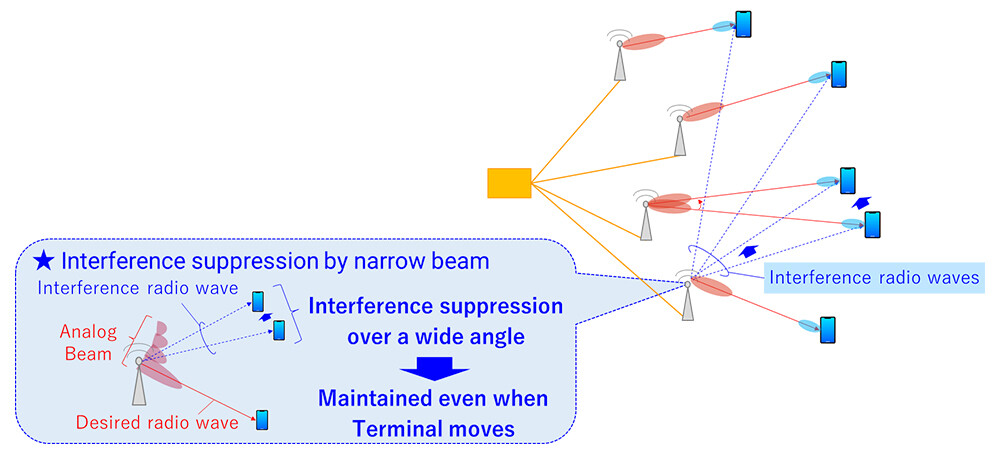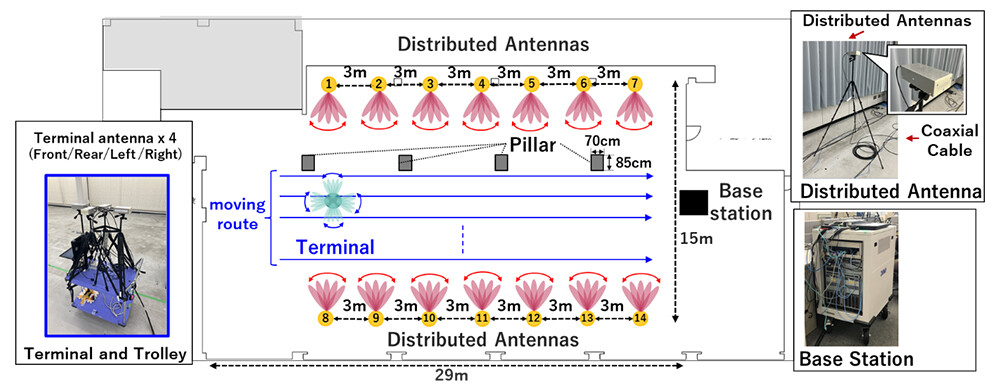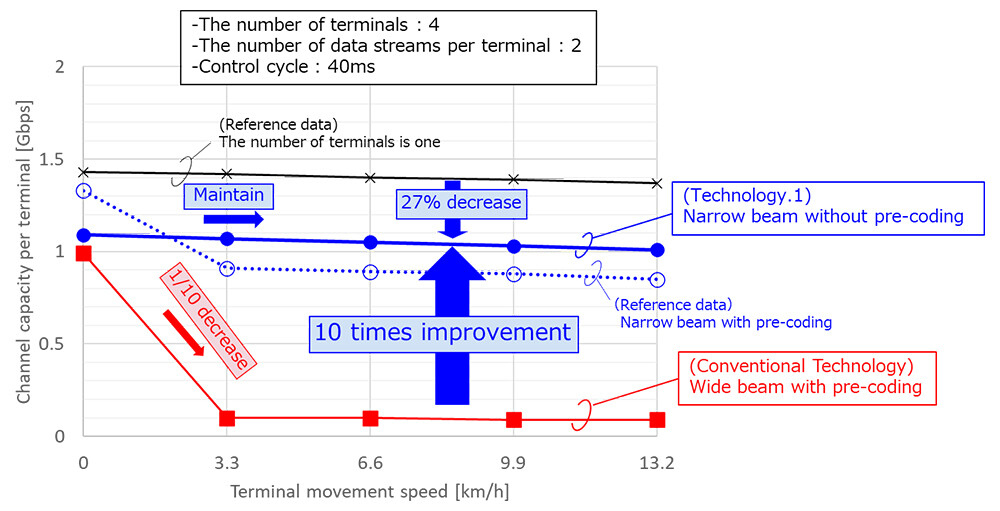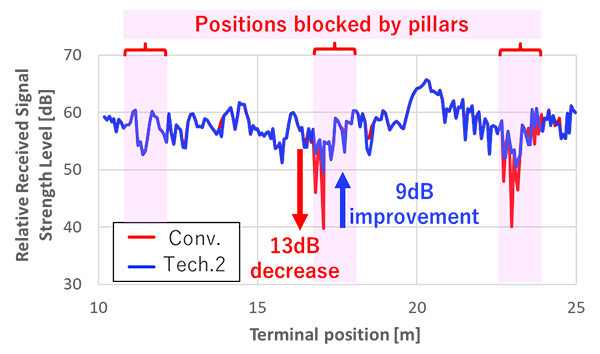Microsoft ends support for Internet Explorer on June 16, 2022.
We recommend using one of the browsers listed below.
- Microsoft Edge(Latest version)
- Mozilla Firefox(Latest version)
- Google Chrome(Latest version)
- Apple Safari(Latest version)
Please contact your browser provider for download and installation instructions.
October 31, 2023
Nippon Telegraph and Telephone Corporation
NTT DOCOMO, INC.
NEC Corporation
Successful 40 GHz band distributed MIMO demonstration of maintaining radio communication quality even when interference occurs due to movement of multiple users
~ Progress in realizing high-capacity communications at event venues and factories where many radio terminals are active ~
Nippon Telegraph and Telephone Corporation (Head Office: Chiyoda-ku, Tokyo, President and CEO: Akira Shimada, hereinafter "NTT"), NTT DOCOMO, INC. (Head Office: Chiyoda-ku, Tokyo, President & CEO: Motoyuki Ii, hereinafter "DOCOMO"), and NEC Corporation (Head Office: Minato-ku, Tokyo, Director, Representative Executive Officer, President and CEO: Takayuki Morita, hereinafter "NEC") have succeeded in a demonstration experiment confirming the same channel capacity even when moving by using multi-user transmission technology (Technology 1) that maximizes the interference suppression effect of analog beamforming *1 formed by each distributed antenna *2 when multiple radio terminals transmit over the same frequency channel at the same time (multi-user transmission) in 40 GHz band distributed MIMO *3 use cases in which multiple distributed antennas are slaved to the same base station.
This demonstrates the possibility of realizing stable, high-capacity wireless transmission by utilizing 40 GHz band distributed MIMO even in environments *4 characterized by the presence of many radio terminals such as XR (Cross Reality) terminals and unmanned transport vehicles at event sites and factories.
Specifically, an experimental distributed MIMO configuration simulating 14 distributed antennas installed as base stations in an indoor area of 29 m×15 m hosting 4 moving radio terminals was constructed, and the following trials were conducted. First, a narrow analog beam ("narrow beam") was applied to both the distributed antennas and the terminal antennas. In this configuration, a multiuser transmission technology (Technology 1) was evaluated to select combinations of the distributed antenna, radio terminal, and beam so as to maintain the reception level at a high level. Whereas with the conventional technology that performs interference suppression only by pre-coding *5, the channel capacity decreased by 90% when the radio terminals moved, with Technology 1 there was basically no drop in channel capacity from the stationary radio terminal case. In addition, by predicting the subsequent position of the radio terminal and selecting the optimal antennas and beams before the radio wave became blocked (Technology 2), it was demonstrated that the 40 GHz band distributed MIMO can achieve stable and high-capacity wireless transmission even in an environment with blockage.
In the future, for the practical application of distributed MIMO, we will conduct demonstration experiments in real service environments such as in front of stations and event venues where there are many terminals, and we will investigate the application and expansion of distributed MIMO technology in higher frequency bands such as the sub-terahertz band in order to expand the application frequency of distributed MIMO.
We will introduce this technology in the NTT R&D Forum 2023 -IOWN ACCELERATION *6 scheduled to be held from Tuesday, November 14, 2023 to Friday 17.
1. Background
With 5G Evolution & 6G, expectations are high for the collection of video and sensing information in a world where cyberspace and physical space are fused, as well as the realization of multi-sensory communication including five-sense information, atmosphere, and a sense of security. In order to achieve these goals, it is essential to further increase the speed and capacity of wireless communications, and consideration is being given to utilizing millimeter wave and sub-terahertz bands, which have higher frequencies than current 5G, for mobile communications.
In these high frequency bands, the attenuation of radio waves due to blocking is large, so it is important to take measures against blockage. A high frequency band distributed MIMO system in which multiple antennas are slaved to a single base station ("distributed antennas") and used for radio transmission to many radio terminals, is a powerful solution *7. NTT, DOCOMO, and NEC conducted a demonstration test of antenna selection technology based on terminal mobility prediction on the basis of the experimental trial collaboration *8 announced in June 2022 for high frequency band distributed MIMO technology, and realized stable, high-capacity radio transmission in an environment with blockage *9.
If interference between radio terminals can be suppressed through the use of multiple distributed antennas, high frequency band distributed MIMO can provide multi-user transmission to radio terminals with as many distributed antennas as possible. Pre-coding is a conventional technique for suppressing interference between radio terminals. Pre-coding is a technique in which, when a base station transmits radio waves to one radio terminal using multiple antennas, interference is suppressed by adjusting the phase and amplitude among the antennas by digital signal processing so that the radio waves do not reach other radio terminals.
However, when multiple distributed antennas are used for pre-coding, the positions at which interference can be canceled are constricted, making it difficult to suppress interference to all moving radio terminals.
2. Contents of the demonstration experiment
■Technology 1: Multi-user transmission technology utilizing narrow beam
In order to solve these problems, NTT and DOCOMO have focused on the fact that the narrow beam present in high-frequency band transmission can suppress interference over a wide range of transmission and reception directions. Accordingly, they have developed a multi-user transmission technology (Technology 1) that makes it possible to suppress interference between radio terminals using only this narrow beam effect. With this technology, we have demonstrated that multi-user transmission to moving radio terminals can achieve the same channel capacity as at rest in high-frequency band distributed MIMO.
Technology Overview
In order for both the base station and the radio terminal to use narrow beams for multiuser transmission, it is necessary to determine who should direct the beam to each other, i.e., the combination of the distributed antenna and each terminal antenna. In order to determine this combination, we have devised a method that observes the reception level when the best analog beams are directed to each entity for each combination, and then selects the distributed antennas with the highest reception level from the combinations available, such that they do not overlap.
Since a narrow beam can suppress interference over a wide direction, this method, which enables the application of a narrow beam on both the distributed antenna side and the terminal antenna side, maintains the interference suppression effect even when the radio terminal moves, and is expected to stably hold the high capacity of multi-user transmission (Figure 1).
 Figure 1 Multi-user Transmission Technology Utilizing Narrow Beams
Figure 1 Multi-user Transmission Technology Utilizing Narrow Beams
Experimental Contents and Results
A demonstration experiment of this technology was conducted in a laboratory with 4 pillars in an area of 29 m x 15 m (Figure 2-1). As for the frequency band used in the experiment, the 40 GHz band was used, which is higher than the 28 GHz band of 5G millimeter wave service in Japan *10. Other physical specifications are based on 5G NR (New Radio), and OFDM *11 with a 100 MHz bandwidth and 60 kHz subcarrier spacing are used. A coaxial cable (20 m long) connected multiple distributed antennas to the base station. We simulated the environment where a maximum of 14 distributed antennas were installed in positions #1 to #14, and the radio terminal was equipped with 4 antennas to cover the 4 directions of front, back, left, and right. The terminal was mounted on a trolley and moved along the route shown in the figure.
We experimentally evaluated the channel capacity characteristics of the downlink when Technology 1 was applied using narrow beams for both the distributed antenna and the terminal antenna and when pre-coding was applied using a wide analog beam (hereinafter referred to as "wide beam") at both sides (Figure 2-2). Specifically, a channel estimate between each distributed antenna and terminal antenna is acquired by using reference signals, and is used for calculation of the channel capacity. As reference data, we also evaluated the channel capacity characteristics when pre-coding was applied to this technology (narrow beam) and when there was only one radio terminal. The pre-coding update period was set to 40 ms, and the horizontal beam width of the narrow beam was about 16 degrees with the horizontal beam direction of -67 to +67 degrees. On the other hand, the width of the wide beam was set to about 60 degrees for the horizontal beam width, and the beam direction was fixed to the horizontal front direction. In order to fairly compare the effects of interference between radio terminals using narrow and wide beams, the beam gain of both beams was set to be equal. The horizontal axis of the graph shows the movement speed of the radio terminal, and the vertical axis shows the channel capacity per radio terminal (hereinafter referred to as "channel capacity"). The channel capacity was evaluated using the value of 50% cumulative distribution in the experiment area. The number of radio terminals was set to 4, and the number of simultaneous transmission streams per radio terminal was set to 2. The radio terminal selected 2 antennas with high reception level from the 4 antennas, and minimum mean square error (MMSE) reception processing *12 was performed using these 2 antennas.
According to the experimental results, when applying a wide beam and pre-coding, the interference suppression effect of pre-coding is local, and the channel capacity deteriorates by 90% at a moving speed of 3.3 km/h or more compared with that at rest. On the other hand, in the case of applying a narrow beam, the channel capacity at rest is maintained even at a moving speed of 3.3 km/h or more because the narrow beam maintains interference suppression over a wide range of direction. In addition, the degradation of the channel capacity is reduced to 27% compared to when only one radio terminal is active. Furthermore, when pre-coding is applied to a narrow beam, the channel capacity deteriorates compared to this technology without pre-coding at a moving speed of 3.3 km/h or higher. However, at rest, the channel capacity is improved compared to this technology, and the channel capacity is almost the same as when only one radio terminal is active. In the future, if the application/non-application of pre-coding can be controlled based on the movement of the radio terminal, we have confirmed the possibility that the application of narrow beams can achieve stable channel capacity regardless of the movement of the radio terminal.
 Figure 2-1 Overview of the experimental area and the experimental system
Figure 2-1 Overview of the experimental area and the experimental system
 Figure 2-2 Experimental results (comparison of channel capacity per radio terminal with the conventional technology and with Technology 1)
Figure 2-2 Experimental results (comparison of channel capacity per radio terminal with the conventional technology and with Technology 1)
■Technology 2: Antenna-beam selection technology based on terminal mobility prediction
On the other hand, when a radio terminal using high frequency band service moves into an environment with blockage, where radio waves do not diffract easily, a sudden drop in radio communication quality or disconnection may occur when a blockage obscures the terminal. NEC has established a technology to predict the occurrence of sudden radio communication quality degradation due to blocking by predicting the subsequent position of the radio terminal, and select the best distributed antenna in advance *9. In this study, we extended this technology to distributed MIMO which performs analog beamforming on both the base station's distributed antenna and the radio terminal's antenna. We developed and demonstrated a technology (Technology 2) to select the optimal distributed antenna and beam before the radio communication quality deteriorates.
Technology Overview
We continuously measure the radio communication quality of each distributed antenna and beam at each position in the area, and learn the optimal distributed antenna and beam combination at each position. During operation, we observe the radio communication quality of each distributed antenna and beam at any time, and estimate the position of the radio terminal by machine learning. Furthermore, we predict the subsequent position of the radio terminal from the estimated movement track of the radio terminal in the past, and predict the optimum distributed antenna and beam before the next radio communication quality information is obtained. As a result, even if there is a possibility that the transmission performance of the distributed antenna and beam selected based on the current radio communication quality information is drastically reduced or disconnection occurs due to the blocking triggered by the movement, this technology enables us to continue radio transmission by selecting the predetermined appropriate distributed antennas and beams based on the predicted subsequent position of the moving radio terminal.
Experimental Contents and Results
In an experimental environment similar to multiuser transmission technology utilizing narrow beams, we conducted a demonstration experiment to verify the effectiveness of this technology under an environment simulating a total of 14 distributed antennas. Specifically, we evaluated the relative received signal strength (relative to a predetermined standard in the device) of downlink transmission using Technology 2 (Figure 3) by using the channel estimate between each distributed antenna and terminal antenna. For example, if the acquisition interval of radio communication quality information is 40 ms, and the radio terminal moves at a jogging speed (6.6 km/h) along the route close to the pillars shown in Figure 2-1, the received signal strength of the conventional technology, which selects the distributed antenna and beam based on the current radio communication quality, decreased by about 13dB at the position blocked by the pillar. On the other hand, in Technology 2, which selects distributed antennas and beams based on terminal mobility prediction, the received signal strength at the same position is improved by about 9dB compared with the conventional technology, and the degradation in the received signal strength is restrained to about 4dB, confirming that it is possible to avoid disconnection, which is a concern in high-frequency band service. By using Technology 2 together with Technology 1, we can expect to realize stable, high-speed, high-capacity communication in the high-frequency band even when moving next to blockage.
 Figure 3 Experimental Results (Relative Received Signal Strength Characteristics of Conventional Technology and Technology 2 Application)
Figure 3 Experimental Results (Relative Received Signal Strength Characteristics of Conventional Technology and Technology 2 Application)
3. Future Development
In the future, we will continue research and development activities to expand the application area of high-frequency band distributed MIMO systems by conducting demonstration experiments at event venues and factories where a large number of moving radio terminals are densely packed, which is considered to be a potential high-capacity wireless communication need, and in real field environments such as shopping malls and roadways where a large number of blockages such as human bodies and cars are densely packed, which are considered to be problematic in terms of ensuring high-frequency band wireless communications.
We will also conduct demonstration experiments on frequency bands higher than the 40 GHz band, such as the sub-terahertz band, which are expected to be used for ultra-high-speed, high-capacity wireless transmission toward 6G, and we will also promote research on expanding the application frequency band of distributed MIMO.
< Glossary >
*1:Analog beamforming
An antenna technology that transmits the same signal from a number of antenna elements and enhances the transmission/reception level of radio waves in a specific direction by adjusting the phase difference of analog circuits between the elements. This specific direction can be changed by changing the phase difference.
*2:Distributed antenna
In distributed MIMO, an antenna slaved to one base station
*3:Distributed MIMO (Multi-Input Multi-Output)
A technology that distributes a large number of antennas slaved to a single base station in one area and MIMO transmission is established between each antenna and radio terminal in the area.
*4:Beyond 5G Promotion Consortium White Paper Subcommittee "Beyond 5G White Paper - Messages for the 2030s - Version 2.0," 2023.3.31 https://b5g.jp/doc/whitepaper_en_2-0.pdf
*5:Pre-coding
Interference suppression technology that, when a base station transmits a radio wave to a certain radio terminal using multiple antennas, cancels interference at the position of the other radio terminal by phase and amplitude adjustment between the antennas by digital signal processing so that the radio wave does not arrive at other radio terminals.
*6:NTT R&D FORUM 2023 -IOWN ACCELERATION Official Website
URL: https://www.rd.ntt/e/forum/
*7:"White Paper 5G Evolution and 6G" NTT DOCOMO, INC. November 2022 (5.0 Edition)
https://www.docomo.ne.jp/english/binary/pdf/corporate/technology/whitepaper_6g/DOCOMO_6G_White_PaperEN_v5.0.pdf
*8:https://group.ntt/en/newsrelease/2022/06/06/220606a.html
*9:https://group.ntt/en/newsrelease/2022/10/31/221031a.html
*10:The 40 GHz analog beamforming IC technology used in the experiment was developed by NEC Corporation with the support of the Ministry of Internal Affairs and Communications in Japan (JPJ000254).
*11:OFDM (Orthogonal Frequency Division Multiplexing)
*12:MMSE (Minimum Mean Square Error) reception processing
Linear equalization processing using multiple antennas so that the mean square error from the desired signal is minimized
About NTT
NTT contributes to a sustainable society through the power of innovation. We are a leading global technology company providing services to consumers and business as a mobile operator, infrastructure, networks, applications, and consulting provider. Our offerings include digital business consulting, managed application services, workplace and cloud solutions, data center and edge computing, all supported by our deep global industry expertise. We are over $95B in revenue and 330,000 employees, with $3.6B in annual R&D investments. Our operations span across 80+ countries and regions, allowing us to serve clients in over 190 of them. We serve over 75% of Fortune Global 100 companies, thousands of other enterprise and government clients and millions of consumers.
About NTT DOCOMO
NTT DOCOMO, Japan's leading mobile operator with over 88 million subscriptions, is one of the world's foremost contributors to 3G, 4G and 5G mobile network technologies. Beyond core communications services, DOCOMO is challenging new frontiers in collaboration with a growing number of entities ("+d" partners), creating exciting and convenient value-added services that change the way people live and work. Under a medium-term plan toward 2020 and beyond, DOCOMO is pioneering a leading-edge 5G network to facilitate innovative services that will amaze and inspire customers beyond their expectations.
https://www.docomo.ne.jp/english/
About NEC Corporation
NEC Corporation has established itself as a leader in the integration of IT and network technologies while promoting the brand statement of "Orchestrating a brighter world." NEC enables businesses and communities to adapt to rapid changes taking place in both society and the market as it provides for the social values of safety, security, fairness and efficiency to promote a more sustainable world where everyone has the chance to reach their full potential. For more information, visit NEC at http://www.nec.com.
Contact from the press regarding this matter
NTT Information Network Laboratory Group
Planning Department, Public Relations Section
nttrd-pr@ml.ntt.com
NTT DOCOMO, INC.
Public Relations Officer, Brand Communications Department
dcmpr@nttdocomo.com
For inquiries regarding this matter, please contact:
NTT Information Network Laboratory Group
Planning Department, Public Relations Section
nttrd-pr@ml.ntt.com
NTT DOCOMO, INC.
Public Relations Department, Brand Communications Department
dcmpr@nttdocomo.com
NEC Corporation
Network Service Planning Dept.
contact@nwsbu.jp.nec.com
Information is current as of the date of issue of the individual press release.
Please be advised that information may be outdated after that point.
NTT STORY
WEB media that thinks about the future with NTT











